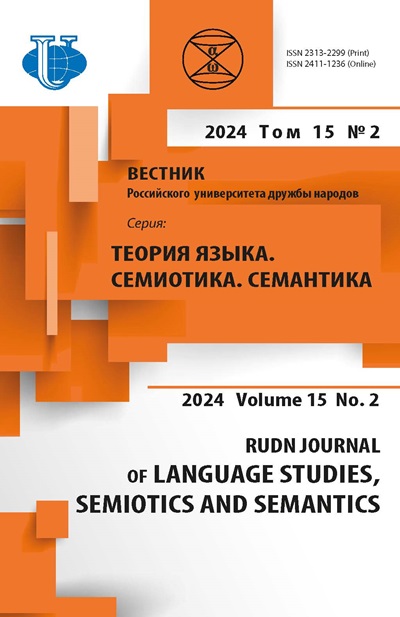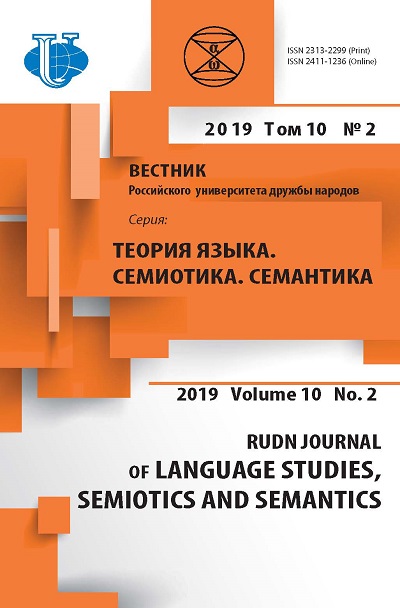OPTIONS OF PHRASEOLOGICAL UNITS CONTAINING TEONIMA IN THE AZERBAIJAN LANGUAGE
- Authors: Sadigova A.P.1
-
Affiliations:
- Azerbaijan Technical University
- Issue: Vol 10, No 2 (2019)
- Pages: 373-380
- Section: PHRASE RESOURCES
- URL: https://journals.rudn.ru/semiotics-semantics/article/view/21755
- DOI: https://doi.org/10.22363/2313-2299-2019-10-2-373-380
Cite item
Full Text
Abstract
In the article, the idea is put forward that in the phraseological system of the Azerbaijani language, alliteration and assonances are less active in the manifestations than in other languages. Comparative analysis of theonyms and demonims in composite phraseological units in the Azerbaijani language shows that a sufficient degree of functionality is demonstrated here not only by the presence of types of sound reproduction of both sound repetitions, but also by the widespread joint (alliterativeassonance) model of figurative phonetic image techniques.
About the authors
Ayten Pilahga kyzy Sadigova
Azerbaijan Technical University
Author for correspondence.
Email: sadiqovayten@gmail.com
PhD in Philology, lector at Azerbaijan Technical University
25, Geseyn Javid Avenue, Baku, Azerbaijan, AZ 1148References
- Seidaliev, N. (2006). Phraseology of the language of Azerbaijani dastans and fairy tales. Baku. (In Azerbaij.).
- Zhirmunsky, V.M. (1964). Ritmiko-syntactic parallelism as the basis of ancient Turkic folk epic verse. Voprosy Jazykoznanija, 4, 3—24. (In Russ.).
- Demirchizade, A. (1962). Stylistics of the Azerbaijani language. Baku: Azertedrisneshr. (In Azerbaij.).
- Babkin, A.M. (1990). Russian phraseology, its development and sources. Leningrad: Nauka. (In Russ.).
- Buslaev, F.I. (1954). Russian proverbs and sayings, collected and explained. Moscow: Russian language. (In Russ.).
- Bazarova, L.V. (2011). Constructive analysis of phraseological fields on the material of phraseological units representing the concept of God in the English, Russian, Tatar and Turkish languages. Art criticism. Issue 56, 20 (235), 25—30. (In Russ.).
- Bazarova, L.V. (2011). Concept God in the phraseological units of the English, Russian, Tatar and Turkish languages [dissertation]. Kazan'. (In Russ.).
- Velikorodchanina, L.A. (2012). Features of the functioning of Biblical in English and Russian languages. Bulletin of the Moscow Region State University. Series: Linguistics, 1, 64—70. (In Russ.).
- Gal'perin, I.R. (2007). Text as an object of linguistic research. Moscow: KomKniga. (In Russ.).
- Dolgov, A.O. (2006).What are the standard images presented in phraseological comparisons? Russian language and literature, 7, 50—55. (In Russ.).
- Grigorieva, L.L. (2010). Phraseological representation of the religious world of man [dissertation]. Kazan'. (In Russ.).
- Gizatov, G.K. (2010). Structural and typological approach to the comparative study of phraseology [dissertation]. Kazan'. (In Russ.).
- Dachko, E.M. (2006). Models of the euphemization of theonyms in the Pentateuch of Moses. Bulletin of the South Ural State University. Series: Linguistics, 6 (61), 138—141. (In Russ.).
- Mirzaliyeva, M.M. (1995). Theoretical problems of the phraseology of the Turkic languages. Baku. (In Russ.).
- Mirzaliyeva, M.M. (2009). Phraseology of Turkic languages. Baku. Vol. 1. (In Russ.).
- Orujov, A.A. (1976). Azerbaijani-Russian phraseological dictionary. Baku.
- Ganiyev, F.F. (2015). Phraseological units as an object of study in the works of domestic researchers. Lingua mobilis, 1 (52), 38—47. (In Russ.).













